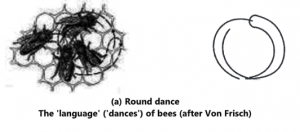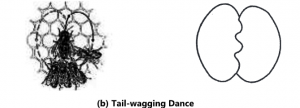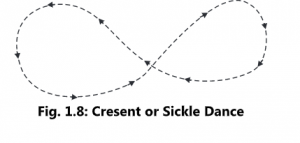Contents:
Bee Behaviour
Swarming:
The phenomenon of leaving off the colony by the queen and other members is known as swarming. It is taking place towards the end of spring or early summer but the true season is of swarming is still not well known. In the summers, when plenty of food is available and hive is overcrowded by the bees the queen leaves the hive on a fore-noon with some old drones and workers and establishes a new colony at some other place.
Supersedure:
When the egg laying capacity of the old queen is lost or is suddenly dies, a new young and vigorous queen takes the position of the old queen is called supersedure.
Absconding:
The migration of the complete colony from one place to another place due to some unfavourable conditions of life, such as destruction of the comb by termites or wax moths and scarcity of nectar producing flowers around the hive. This phenomenon is quite different from swarming. In such a case, the entire colony leaves the hive to find a new home elsewhere, absconding appears to serve one purpose only, that of removing the whole colony from an unfavourable situation or environment and if a chance of finding a more favourable place. The selection of the nest site is done by considering the following points: (1) Plenty of food available, (2) Protection from heat, rain, wind etc. (3) Distance from another hive (bees usually don’t select place nearer to another hive).
Nuptial flight:
After swarming, the new virgin queen is followed by the drones in clear, sunny days is called nuptial flight. One of the drones start copulating with the queen in the sky and fertilizes the queen and dies during the course of copulation. The queen receives sperms and store them in spermatheca and reaches to the hive. This whole phenomenon is known as nuptial flight or marriage flight.
Communication in Bees
Honey bees have an unique and one of the best understood animal languages with which they inform each other about distance and direction of the source of food.
- This system of communication (language) was identified and discovered by Austrian Zoologist Karl-von-Frisch at the University of Munich, Germany.
- Prof. Karl Von Frisch has spent many years to study the behaviour and experiments in the early 20s. He kept a dish of sugar solution near its hive, the bees start arriving there, goes back to the hive; the first bee must have informed others in the hive.
- After long experimentation, Karl Von-Frisch put colour dots on the thorax of bees to identify them from their fellows and observed their behaviour after they returned from the sugar solution dishes kept at varying distances from the frame hive which he kept in glass hive for easy observation. He found that the Forager bee on return to the nest makes two kinds of dances on the vertical surface of the comb.(i) Round dance (Rundtanz)
(ii) Tail-wagging dance (Schwanzeltanz).
(i) Round Dance:
- The round dance is used to direct a short distance i.e. less than 50 metres (i.e. A. mellifera).
- This dance performed by the bees indicate or tells their sisters that the source of food is close to the hive but when they did a shuffie on returning to the hive, the foraging bees prepared for a long flight.
- In the round dance, the bees run in circles, first in one and then in opposite direction (clock and anticlockwise). In fact, she traces out a figure of eight with its two loops more or less closely superimposed upon one another.
- The performer bee do this dance for half a minute or more on same part of comb and latter repeats it on the another part of comb to demonstrate other group of bees.
- Some of the workers in the hive closely follow the dance and may partly join it. Eventually, they leave the hive to secure more of the honey.

(ii) Tail-wagging Dance:
- If the source of food discovered by a forager is more than about 50 metres away (i.e. in case of A. mellifera}, it performs a different dance on its return.
- In which the bee runs along semicircles, alternately left and right, ending each turn with a straight run back to her starting point.

- During the straight run, the bee shakes (wags) its abdomen from side to side so called tail-wagging dance.
- Von Frisch found that the number of wags per unit time was related to the distance the food was located. More the wags indicate that the food source was nearer.
- For example: A. indica perform 10.5 shakes (wags) in 15 seconds, indicated a distance of SO feet and 4.4 wags showed 1000 feet. These figures vary with different bees species.
- The tail-wagging dance also indicates the direction of the food supply. The signal depends upon the bees use of the sun as a compass and of polarized light, if the sun is obscured.
- If the wagging dance run is carried out in vertically upwards on the comb the feed place lies in the same direction as the sun, while if it is carried out downwards the feeding place is situated away and opposite direction from the sun.
- The performer runs upwards to the left at a certain angle to the vertical, the feeding place lies at the same angle to the left of a straight line between the hive and the sun and so on. It is also shown that the majority of recruits do not change more than 15° from the correct direction.

(iii) Massage Dance:
- When bees are sick or tired then massaging is required. The sick bee requiring massaging bends her head in a peculiar way with mandibles wide open and tongue protruded out which is dry.
- Then other bees {neighbouring bees) get excited, climb over and under her, then pull the joints of fore, mid and hindlegs, touch the sides with antennae and mandibles, clean the tongue and sometimes lick the bee.
- During massaging the tongue may be unfolded or completely distorted and cleaned. After several minutes, the cleaning activities ceases and the bee starts working normally.
- This dance is observed usually in the fall or during the winter. The same treatment is given to the chilled bees in early spring placed on the entrance of their lives.
(iv) DVAV Dance (Joy dance):
- DVAV dance first observed by Haydak (1945) among bees. The DVAV is a short form of dorso-ventral abdominal vibration, this name is proposed by Milium (1955).
- Originally, it was named as ‘Joy dance’ by Haydak (1945). While performing this dance, the dancer bee places her front legs on some part of the body of another bee, then makes 5-6 shaking movements up and down with the abdomen.
- There is a simultaneous slight swinging forward and backward. This bee then goes to various locations, touches other bee and perform the same dance.
- The field bees perform this type of dance either on a sealed queen cell, after the emergence of virgin queen (new) from queenless colony or when the conditions in the hive are optimum. Many bees (workers) perform this dance during field duties.
- The dance is observed on many occassions, at all hours of the day and night, at all seasons, even in queenless colonies. Many times DVAV dance may be intermixed with wag-tail or crescent dances.
(v) Alarm Dance:
- This type of dance is performed by bees when the condition in the colony is critical. Different substances or disturbances cause these dances.
- While performing alarm dances, the bees ran in spirals or irregular zig-zags with vigorously shaking their abdomen sidewise (vibrations). The flight activity of bees is stopped completely and neighbouring bees began to respond to dancers.
- Schneider (1949) observed alarm dances when the sugar solution is contaminated with dinitrocresol in hive box, because the bees get excited and show increased dancing activity with the spread of poison. After about 3-4 hours the colony returned to normal activities and flight activity was resumed again.
(vi) Intermediate Sickle or Crescent Dance:
- In one of races of bees, this dance is performed. The bees show a rapid transition from the round dance to the wag-tail dance, but in other races there is a slow transition called the sickle dance.
- Variations are performed when the food source is between 25 to 100 metres from the hive.

(vii) Cleaning Dance:
- The bee begins to dance when it requires cleaning. During dancing the bee shows rapid stamping of the legs and swinging of the body with cleaning the bases of the wings.
- The cleaner attempts the dancer. The dancer stops dancing when the cleaner touches the base of wings of dancer bee.
- The cleaner works with mandibles by raising the forelegs in the air. She cleans wings, thorax and head from one side then climbs to the other side.
- The dancer may then clean its body in general. The cleaner bees are less in number, on an average ten at one time in a colony.